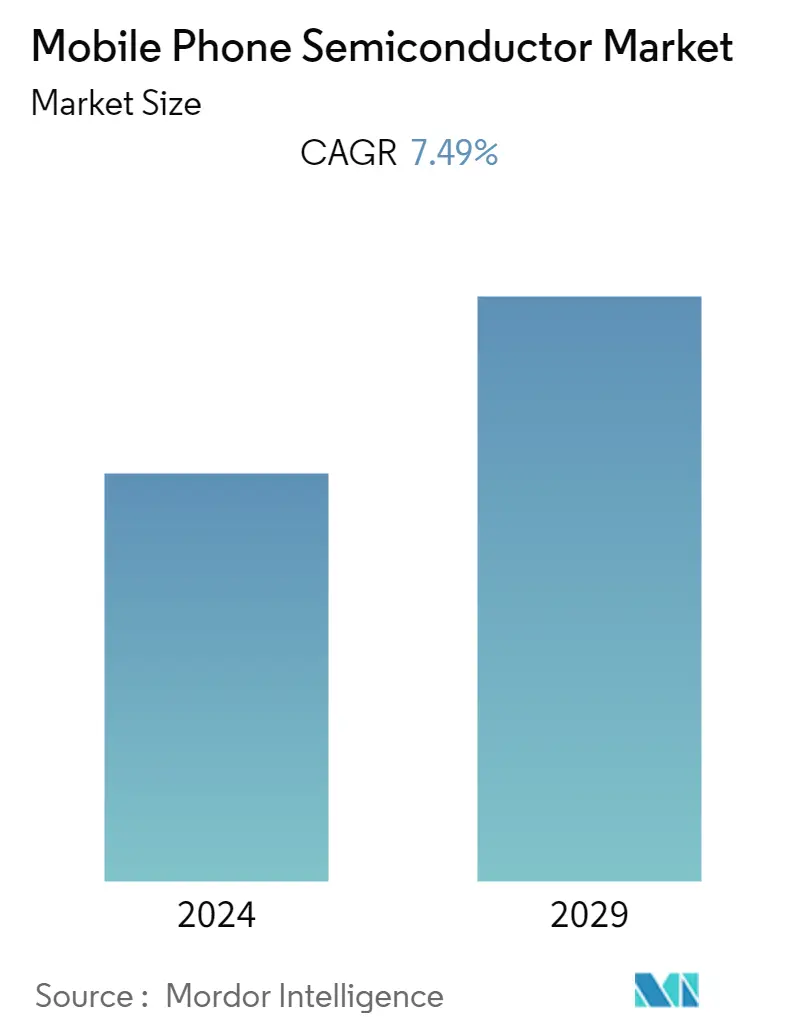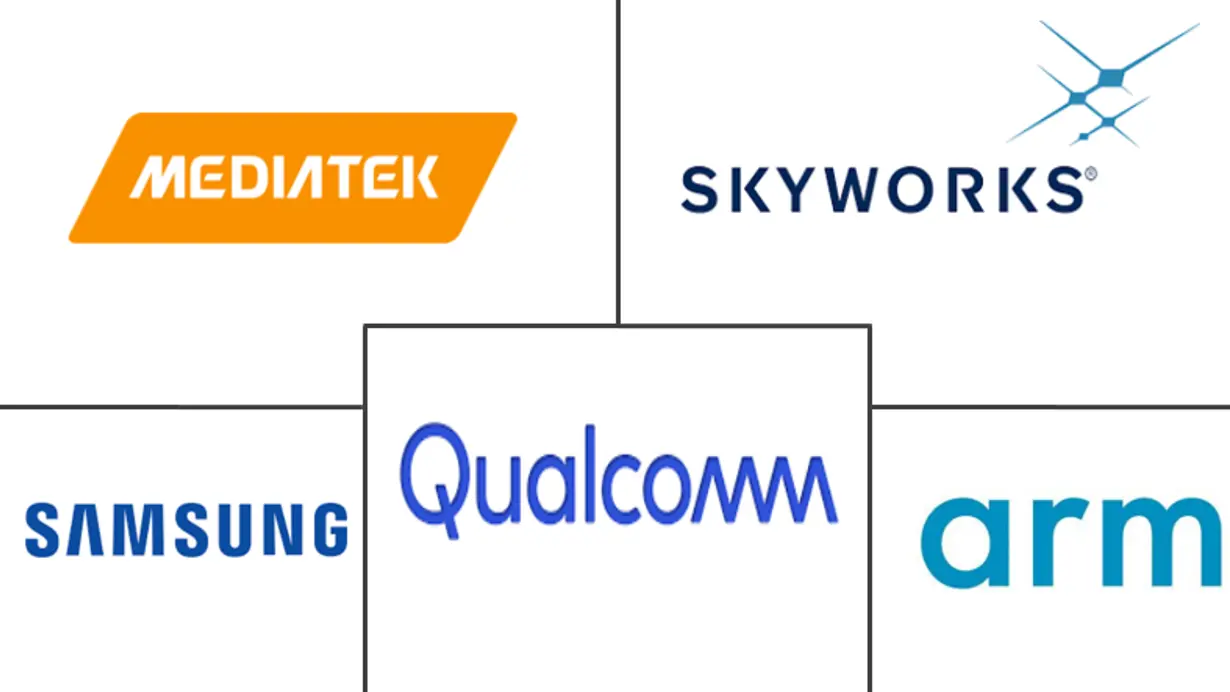Market Size of Mobile Phone Semiconductor Industry

| Study Period | 2019 - 2029 |
| Base Year For Estimation | 2023 |
| CAGR | 7.49 % |
| Fastest Growing Market | Asia Pacific |
| Largest Market | Asia Pacific |
| Market Concentration | Low |
Major Players*Disclaimer: Major Players sorted in no particular order |
Mobile Phone Semiconductor Market Analysis
The Mobile Phone Semiconductor Market grew at a CAGR of 7.49% during the forecast period. The increasing adoption of smart technologies in mobile phones and the rapid introduction of next-generation mobile-communications standards, like LTE or 5G, are some of the major factors driving the adoption of semiconductor components in mobile phones.
- The overall semiconductor industry witnessed lesser growth, and the smartphone business was also fluctuating. However, the mobile phone semiconductor market was able to witness marginal growth, owing to the increasing adoption of RF-based applications in smartphones. In many regions, especially Asia-Pacific, the smartphone business was the largest consumer of the semiconductor industry.
- Since the past year, the smartphone industry has been witnessing a nearing maturity state which is affecting the mobile phone semiconductor industry. However, with the advent of 5G technology and the government's approval for the adoption of 5G technology, it is expected to enable smartphone users to shift from phones supporting 4G and LTE technology to 5G technology which would create huge opportunities for the studied market.
- With the increasing shipments of mobile devices such as tablets, smartphones, and e-book readers have been growing and are driving the growth for a range of semiconductor components, including applications processors, modems, MEMS sensors, wireless connectivity ICs, and audio ICs in these devices.
- The increased revenue of RF was generated from its growing adoption among more bands, a larger number of carriers aggregated, and higher-order MIMO configurations supported by an increase in smartphone ASPs. This trend was expected to continue in 2019, with the addition of the mid-band spectrum for sub-6GHz 5G and mmWave modules in some 5G phones.
- Changes in the semiconductor supply chain, the market fluctuation due to the US-China trade war, the Russia-Ukrain war, and the shifting business models created opportunities for some manufacturers while posing a threat to others.
- However, the significant outbreak of the COVID-19 pandemic globally disrupted the supply chain and production, especially in the Asia-Pacific region. Major semiconductor manufacturing industries have been significantly affected as a result of Asia-Pacific being a world production center over the past two to three decades.
Mobile Phone Semiconductor Industry Segmentation
The Mobile phone semiconductor market encompasses the semiconductors that are used in mobile phones. The increasing usage and adoption of smartphones are resulting in the growing usage of semiconductors in these devices.
The Mobile Phone Semiconductor Market is segmented by Component Type (Mobile Processors, Memory, Logic Chips, Analog), and Geography (North America, Europe, Asia Pacific, Latin America, MEA). The market sizes and forecasts are provided in terms of value (USD million) for all the above segments.
| Component Type | |
| Mobile Processors | |
| Memory | |
| Logic Chips | |
| Analog |
| Geography | |
| North America | |
| Europe | |
| Asia Pacific | |
| Latin America | |
| Middle East and Africa |
Mobile Phone Semiconductor Market Size Summary
The Mobile Phone Semiconductor Market is experiencing growth driven by the increasing adoption of smart technologies and the rapid rollout of next-generation mobile communication standards like 5G. Despite the overall semiconductor industry facing challenges, the mobile phone segment has seen marginal growth due to the rising use of RF-based applications in smartphones. The Asia-Pacific region stands out as a significant consumer of semiconductors, with countries like India, Vietnam, and Thailand witnessing a surge in smartphone manufacturing. This region's dominance is further bolstered by major companies establishing manufacturing units, such as Apple's large-scale facility in India, which is expected to enhance the mobile phone semiconductor market.
The market is characterized by technological advancements in cloud computing and virtual reality, which are driving demand for various semiconductor components. Companies like Micron Technology are expanding production capacities to meet this demand, supported by initiatives like the CHIPS and Science Act. The market is highly fragmented, with key players such as Samsung Electronics and Qualcomm Technologies leveraging strategic collaborations to enhance their market presence. Emerging memory technologies pose a challenge to traditional DRAM demand, but the overall market is poised for growth, particularly in the Asia-Pacific region, where semiconductor production is on the rise.
Mobile Phone Semiconductor Market Size - Table of Contents
-
1. MARKET DYNAMICS
-
1.1 Market Overview
-
1.2 Introduction to Market Drivers and Restraints
-
1.3 Market Drivers
-
1.3.1 Rapid Introduction of Next-generation Mobile-communications Standard, LTE or 4G
-
1.3.2 Emergence of 'Multicom' Solutions
-
-
1.4 Market Restraints
-
1.4.1 Complexity Regarding Manufacturing
-
1.4.2 Consumer Demand Exceeding Factory Capacity
-
-
1.5 Industry Attractiveness - Porter's Five Forces Analysis
-
1.5.1 Bargaining Power of Buyers
-
1.5.2 Bargaining Power of Suppliers
-
1.5.3 Threat of New Entrants
-
1.5.4 Threat of Substitute Products
-
1.5.5 Intensity of Competitive Rivalry
-
-
1.6 Industry Value Chain Analysis
-
1.7 Assessment of Impact of COVID-19 on the Market
-
-
2. MARKET SEGMENTATION
-
2.1 Component Type
-
2.1.1 Mobile Processors
-
2.1.2 Memory
-
2.1.3 Logic Chips
-
2.1.4 Analog
-
-
2.2 Geography
-
2.2.1 North America
-
2.2.2 Europe
-
2.2.3 Asia Pacific
-
2.2.4 Latin America
-
2.2.5 Middle East and Africa
-
-
Mobile Phone Semiconductor Market Size FAQs
What is the current Mobile Phone Semiconductor Market size?
The Mobile Phone Semiconductor Market is projected to register a CAGR of 7.49% during the forecast period (2024-2029)
Who are the key players in Mobile Phone Semiconductor Market?
Samsung Electronics, Arm Limited, Qualcomm Technologies, Inc., MediaTek Inc. and Skyworks Solutions Inc. are the major companies operating in the Mobile Phone Semiconductor Market.


